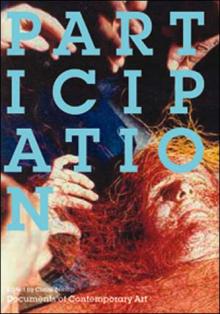Participation, ed. by Claire Bishop
This review was published in the The Journal of Aesthetics and Art Criticism, Vol. 66, No. 3 (Summer, 2008), pp. 309-311. A copy of the published version can be downloaded here, or this post can be cited as: Buckner, Clark. “Participation, ed. by Claire Bishop.” Resonator. Web. Day Month Year the post was accessed.
In her article, “Antagonism and Relational Aesthetics,” (October, Fall 2004) Claire Bishop takes issue with several central claims of Nicolas Bourriaud’s book, Relational Aesthetics. Bourriaud became prominent in the 1990s as a critic and curator, who championed a stable of artists, including Rirkrit Tiravanija, Liam Gillick, Pierre Huyghe, and Christine Hill, among others, whose artworks in one way or another engage human interactions and their social contexts rather than asserting private symbolic spaces. This work, which Bourriaud dubbed, “relational art,” belongs to the broader field of installation art but is distinguished by an additional emphasis on the uses to which these constructed spaces are put. For example, Tiravanija’s art characteristically entails meals of vegetable curry or pad thai cooked and served to participating audience members, who do not stand as isolated viewers in one-to-one relationships with the work, but rather come to constitute something like a community – if only momentarily. The emphasis on social relationships immediately invests this work with political significance. But Bourriaud is careful to distinguish these politics from those of its precursors in the 1960’s and before. Contemporary relational artists, he contends, do not maintain the same teleological, utopian aspirations as the avant-gardes of the twentieth-century. They relinquish any claim to critique society as a totality for being predicated upon an untenable pretense to marginality. Instead they construct, what he calls, “micro-topias,” which renounce social change through conflicts and clashes, but nevertheless mount implicit critiques of modern mass culture and elaborate alternative forms of sociability.
Bishop argues that Bourriaud fails to address the quality of the relationships in relational aesthetics. He idealizes community by treating it exclusively in terms of the structure of the artwork that he contends produces it; but he never reflects on the relationship between a work’s form and the specific conditions that define its content. Who is the public? How is the culture made? And who is it for? Correlatively, Bishop challenges the model of democracy as congeniality, which Bourriaud celebrates in this work, by appealing to the political philosophy of Chantal Mouffe and Ernesto Laclau. They argue that democratic society is one in which antagonism has not been exhausted, but rather is essential. New political frontiers must constantly develop and be debated. Without antagonism there is only the imposed consensus of the status quo. And in Bourriaud’s defense of relational art, Bishop argues, his failure to consider the concrete social differences, defined by various forms of antagonism, obscures the politics of communication rather than addressing them.
In response to Bourriaud’s relational aesthetics, Bishop elaborates a theory of relational antagonism. And, as foils to the artists he champions, she defends work by artists who similarly thematize the relationships between members of their audiences, but do not thereby collapse these relationships into the form of the work itself. Among them, Santiago Sierra provides a particularly vivid example. The titles of his works serve to describe them: “250cm Line Tattooed on Six Paid People;” “Workers Who Cannot Be Paid, Remunerated to Remain Inside Cardboard Boxes,” etc. Whereas artists like Tiravanija thematize context without addressing its concrete determinations, Bishop contends that Sierra situates his projects in relationship to specific social conditions, such as immigration, wages, street commerce, and homelessness, in order to highlight the divisions they entail. And, while some dismiss Sierra’s work as merely nihilistic or tritely stating the obvious fact that capitalism exploits, Bishop reads it as democratic specifically because it provokes moments of racial and economic non-identification, which provide concrete polemical grounds for rethinking our relationships to one another and the world.
In the broader framework of contemporary debates concerning the politics of aesthetics, Bishop’s argument has the great virtue of articulating a position beyond the impasse between post-modern acquiescence and modernist refusal. The art she defends concedes its complicity in the broader framework of social and cultural institutions, but it does not thereby affirm them. It maintains a critical negativity in its attention to antagonism, without therefore withdrawing into the melancholy of the lost promise of art’s autonomy.
In Participation Bishop has organized a collection of essays that document the “relational” dimension of contemporary art, situate it loosely in art history, and articulate its complexities and contradictions. It belongs to the book series, White Chapel: Documents of Contemporary Art, published by MIT Press and London’s Whitechapel Gallery, which explores defining aspects of contemporary art by bringing together central articles in which they have been identified and through which they have been articulated. Other titles in the series include The Archive, The Artist’s Joke, The Cinematic, Color, Design and Art, The Everyday, and The Gothic. The book is divided into three sections consisting of theoretical essays, artists writings, and critical-curatorial positions, which are arranged in that order, but read better (and perhaps should have been organized) beginning with the artists’ statements, followed by critical-curatorial defenses of the work, and only finally turning to broader theoretical reflections on art and social life more generally.
Most of the writings by artists included in Participation locate the explorations of social dynamics in art since the 1950s within the broader framework of attempts to breakdown the distinction between art and life. But their motivations and strategies for doing so are diverse. For some, like Alan Kaprow, the problem is primarily aesthetic: an attempt to subvert the conventions of theater, to unearth the performative dimensions of painting, and to engage the rich aesthetic underdetermination of the modern world. For most other artists included in the book, however, the problem of art’s relationship to the everyday is loaded with political significance. But they are still further distinguished by their distinct concepts of modern society and political action. In the included excepts from Guy Debord’s Towards a Situationist International, for instance, he explains his attempt to subvert the distinction between art and life in terms of the New Left’s extension of Marx’s critique of commodity-fetishism to bourgeois culture as a totality. Both the purported autonomy of fine art and the spectacles of consumer culture are, for Debord, reifications of social dynamics, which he wants to shatter and reanimate by constructing situations, which activate the audience not only as participants in the ‘piece’ but as agents in the world’s transformation. Joseph Beuys treats art similarly as a revolutionary power. But he explicitly divorces his interest in social sculpture from Marxist considerations of class, by appealing instead to the universal concept of “man,” advocating direct democracy rather than socialist revolution, and proclaiming “every human being is an artist.” (p.125)
Many of the projects described in this first section of the book captured my imagination – but they also piqued my skepticism. For instance, I am sympathetic to Beuys’ attempt to provoke his audience to engage the aesthetics of the world in which they live, as the realization of the social dimension in art, which has been recognized by philosophers at least since Kant’s discussion of the sensus communus. But when he so facilely insists that we all are artists, I can’t help but wonder what the value is at stake: is this a subversion of the fetishism of artwork, or an extension of it? When Thomas Hirschhorn insists that “Michel Foucault was an artist,” and “philosophy is art!,” does it deepen one’s appreciation of Foucault’s thinking or strengthen one’s critical acumen? (p.154) Rather than having been integrated into the fabric of life, art seems to have been elevated to a transcendent principle: the highest good. And, while Hirschhorn presents his installations as informal research centers, he in fact relieves his audience of the demanding and isolating work of rigorous critical reflection, by elevating philosophy to catch phrases and treating the names of canonical philosophers and texts like magical incantations.
Above all, the facile extension of art to everyday life belies the development of artwork, over the last several decades, into an ever more specialized profession, which tacitly frames this entire discussion though is never explicitly addressed. In fact, only within this specialized context could a plate of pad thai appear as artwork rather than simply dinner. And self-consciousness of this fact is tacitly registered in Bourriaud’s qualification of the politics of relational art as distinct from the utopian projects of the 1960s. Nevertheless, included in the selection of critical-curatorial positions in Participation is the statement, written by Molly Nesbit, Hans Ulrich Obrist, and Rirkrit Tiravanija, for “Utopia Station,” the project they curated as part of the 2003 Venice Biennale, in which they evoke the promise of a restored social totality, despite the obviously rarified, institutional framework for the exhibit. And, in his critical reflections on the subject, Hal Foster intimates the obvious dialectical conclusion: “perhaps discursivity and sociability are in the foreground today because they are scarce elsewhere… as through the very idea of community has taken on a utopian tinge.” (p.194)
Participation provides a clear, concise framing of questions concerning social relations in art since the 1950s, and presents a range of work and theoretical subtleties that exceed the central contradictions that I have focused on here. Professional aestheticians, art historians, and critics will likely want to seek out the original sources from which many of the included selections have been excerpted. Nevertheless they will find that the book offers a helpful map of the relevant material. And, above all, Participation provides an excellent reader for anyone teaching relational aesthetics, as a defining feature of contemporary art.






